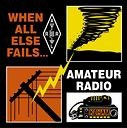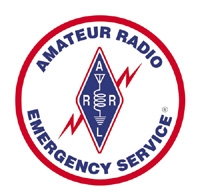
 SUMTER COUNTY
SUMTER COUNTY
Amateur Radio Emergency Services Association (ARES)
Communications Forms - ARRL Forms

Instructions
|
1. Preamble
|
The Preamble includes information used to prioritize and
track the message and ensure its accuracy.
|
||||||||||||||||
|
2. Address
|
Name, address, city, state, ZIP and telephone number of
the intended recipient, as complete as possible. Note
that punctuation is not used in the Address section.
|
||||||||||||||||
|
3.Text
|
The message information, limited to 25 words or less if
possible. Normal punctuation characters are not used in
the text. A question mark is sent as Query, while DASH
is sent for a hyphen. The letter X is used as a period
(but never after the last group of the text) and counts
as a word when figuring the Check. The letter R is used
in place of a decimal in mixed figure groups (example:
146R52 for 146.52).
|
||||||||||||||||
|
4.Signature
|
The name of the party for whom the message was
originated, May include additional information such as
Amateur Radio call sign, title, address, phone number
and so on.
|
GENERAL
Follows a description of the different parts of the Amateur Radio Message format. Some sections are OPTIONAL, and I recommend they not be used, unless needed. The use of this pre-printed message form from ARRL is NOT necessary for handling traffic. Use any paper you seem appropriate.
MESSAGE NUMBER (Mandatory)
This can be any number the originating stations chooses. Most start with 1 the first of each year. Once a message is numbered, that same number remains with the message until delivered. Example: NR 1
PRECEDENCE (Mandatory)
The Precedence of the Message determines what order the messages will be handled. Most of the time all messages are handled on every net session. The following four precedences are used in ascending order of priority:
- ROUTINE (R on CW)
-
99.99% of all messages have this precedence. These messages will be handled last.
- WELFARE (W on CW)
-
This message is either an inquiry to the health and welfare of an individual in a disaster area or a report of the health and welfare of an individual. These messages will be handled before ROUTINE traffic.
- PRIORITY (P on CW)
-
These are messages have specific time limits. They are also for Official messages, not covered in the EMERGENCY category. This traffic will be handled before WELFARE or ROUTINE.
- EMERGENCY (EMERGENCY on CW)
-
Any message having life and death urgency to any person or group of persons, which is transmitted by Amateur Radio in the absence of regular communication facilities. When in doubt, do NOT use this precedence. This traffic will be handle first and immediately.
Example: NR 1 R (for Routine)
HANDLING INSTRUCTIONS (Optional)
Handling Instructions are sometimes used to tell the various stations along the way, what the desires of the originating station are. If not needed, it is best not to use. On phone: the sending station would say, "HANDLING INSTRUCTIONS n", n explained below. On CW: Send HXn.
-
HXA (Followed by a number)
-
Collect landline delivery authorized by the by addressee within ... miles. (If no number, authorization is unlimited).
- HXB (Followed by a number)
-
Cancel message if not delivered within ... hours of filing time; service originating station.
- HXC
-
Report the time and date of delivery to originating station.
- HXD
-
Report to the originating station the identity of the station from which you received, plus time and date. Report the identity of the station to which it was relayed, plus time and date, or if delivered report time and date of delivery.
- HXE
-
Delivering station get a reply from the addressee, and originate a message back.
- HXF (Followed by number)
-
Hold delivery until ... (date).
- HXG
-
Delivery by mail or landline toll call not required. If toll or other expense involved, cancel message and service originating station.
Example: NR 1 R HXG
STATION OF ORIGIN (Mandatory)
This is the call sign of the Amateur Radio Station generating (originating) this message. This call sign, along with the message number, serve as the "serial number" of this message. Any future reference to this message would be: "Number nn of CALL nn4nnn".
Example: NR 1 R K4IWW
CHECK (Mandatory)
This is a count of the number of words used in the TEXT (only) of the message. Words in the address or signature are NOT counted. Groups of figures, letters, combinations of figures and letters, and "X" are counted as words. This is the method that Amateurs use to make sure that the TEXT was received without error. Both the sender and receiver should end up with the same word count (CHECK).
PLACE OF ORIGIN (Mandatory)
This field is the City and State of either the Station of Origin or the person in the Signature. In most cases, this will be the same place.
Example: NR 1 R K4IWW 12 CARY NC
TIME FILED (Optional)
The time the message was originated. You may either use UTC or Local time. Examples: 1615Z or 1115 EST. Most messages do NOT use this field. It is only useful if the message has a short time value.
Example: NR 1 R K4IWW 12 CARY NC 1615Z
DATE (Mandatory)
This is the date the message was originated. In Amateur Radio, we use month and day. The year is NOT used. If the message is over a year old, it should be sent to the circular file.
Example: NR 1 R K4IWW 12 CARY NC 1615Z DEC 20
ADDRESSEE (Mandatory)
The name(s) and address of the person to which this message is going. It looks like the address on an envelope used in snail mail. Include a phone number, if you have it. The more information here, the easier the delivery will be.
Example:
JOHN Q PUBLIC
1234 MAPLE AVE
ANYTOWN NC 27000
919 555 1234
Example: NR 1 R K4IWW 12
DELIVERING STATION INFO (Optional)
This section is rarely used. If the message is to be mailed or hand delivered, it is nice to put your (the delivering station) info here so the addressee can reach you if there is any question, or they want to send a return message. Most messages are delivered by phone.
TEXT (Mandatory)
Finally! This is the message you are sending for the signature person to the addressee. It should be short (usually less than 25 words) and in telegram style. No punctuation is used. The letter "X" is used (similar to STOP in telegrams) to end one idea and start another. Many messages do not even have an "X" in them. Example TEXT:
ARRIVE 7PM DEC 24 X
LOOKING FORWARD TO SEEING YOU
X LOVE
The above TEXT has a count of 12. So the CHECK is 12. As Amateur Radio is non-commercial, the TEXT should have no commercial value. Each Radio Amateur is the judge of what is commercial and what is not.
SIGNATURE (Mandatory)
This is the name if the person sending the message. It may be the name or call of the originating station. However, it is usually the name of a "third party", for whom the originating station is generating the message.
RECEIVED (Optional)
This is for the handling station to write down whom they received the message from. This field is only for the book keeping of the handling station.
SENT (Optional)
This is for the handling station to write down whom they sent the message to. This field is only for the book keeping of the handling station
Last Update: 06/28/2018 © Copyright Sumter County ARES. All Rights Reserved.